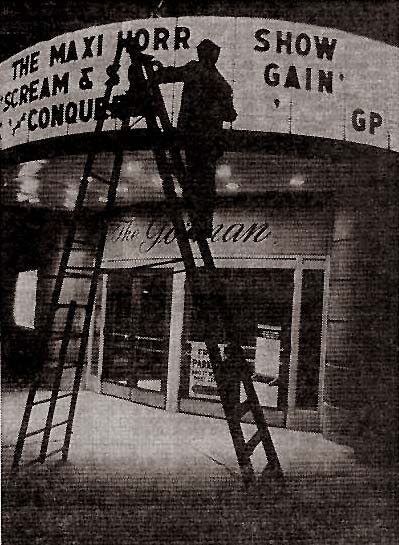The Modern Gorman
1948 thru 1968
From the Giles Company press release of June 1948, this is the description of the "New Gorman" as it reopens after extensive renovations.
"The new Gorman theatre on Kendall Street will open tomorrow night under the management and ownership of John S. Giles, who operates the Giles Circuit of independent motion picture houses, with nine theatres in Boston, Framingham (the St. George), Gardner, Norwood in Massachusetts and Laconia, N.H. For the opening Wednesday night, Mr. Giles and other officials will be present. Chairman William I. Randall of the Selectmen will represent the town, President James F. Power the Chamber of Commerce, and Morris Wolfe, the moving picture industry. There will be an American Legion color guard and Tony Burno's orchestra, formerly of the Latin Quarter, will play.
As the opening night feature the picture will be Van Johnson and June Allison in "The Bride Goes Wild." The following weeks will have Edward G. Robinson in "All My Sun" and Clark Gable and Lana Turner in "Home Coming".
The theatre will operate on a policy of weekly changes of first-run picture bills, opening every Thursday, according to the plan of Mr. Giles and his staff. He has closely followed the progress of Framingham and has brought the new theatre here to keep up with the growth of Framingham and vicinity.
His father acquired the theatre interests here thirty years ago when he purchased the Princess, located where the St. George is now established. After he acquired the old Gorman theatre, he built the St. George theatre, one of the best-known movie theatres in the state, which was opened to the public on April 15, 1921.
With the growth of Framingham, John S. Giles decided that the theatre goers of the area should have another modern theatre. Closely associated with him in the work has been Alden Peterson who was at one time manager at the Gorman and later at the Uptown theatre in Boston. The B.F. Keith theatre, the Gardner Playhouse, and for the past 15 years, the district manager for the Giles circuit. Mr. Peterson is also a resident of Framingham and is known as one of the leaders in moving picture business in New England. The local manager is Anthony Capobianco, who has been connected with the Gorman theatre and the Giles circuit for the past twenty years.
In design, the New Gorman is modern, with all architectural forms strictly functional. Every shape and contour has been determined by reason of practical convenience, acoustics, ventilation or sight lines. The general effect has been obtained by proper proportion and relation of these forms with a pleasing color scheme, rather than with the elaborate decoration of the theatre of the past.
Starting with the front entrance, the curved shape of the lobby automatically directs the low of traffic to the ticket window and into the foyer without crossing the line of exit.
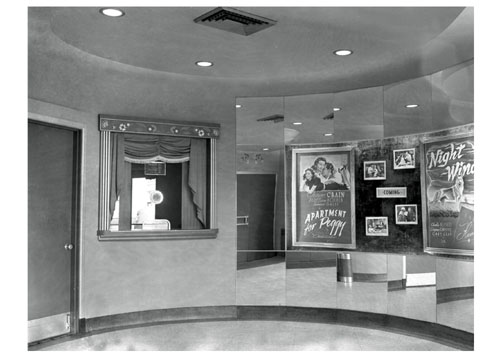
In both the lobby and the foyer cold cathode lights concealed behind plaster ceiling coves produces the soft daylight effect of indirect lighting and bring out the clear, soft colors of the walls and of the rich carpeting.
In the foyer, a wide expanse of plate glass above the stand up rail gives the patron a preview of the main interior.
The focal point of the auditorium is the stage and the wall and ceiling treatment form a simple background to the rich decorations and color of the proscenium arch and stage setting.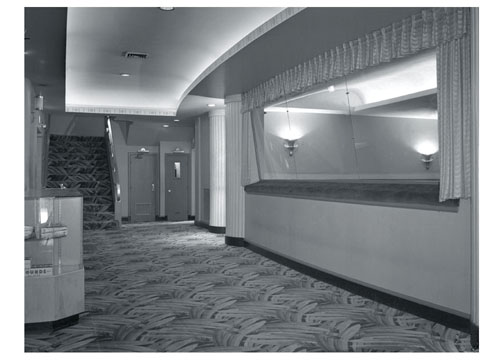
The seating area of the orchestra has been greatly enlarged, but the height of the room has been decreased about ten feet. The ceiling consists of a series of curved segments divided by cross bands of concealed cold cathode lighting coves creating an effect of a floating ceiling. These curved sections serve the purpose of diffusing the sound waves and preventing an echo or sound distortion.
The general color scheme of the walls and ceiling of the auditorium is a coral rose starting with a light shade at the front and grading darker toward the rear. A wainscot color of blue-green provides a pleasing contrast to the warm tones of the walls and ceiling and this cool color is carried as accent in the stage setting and balcony.
Like the architecture, the interior is modern in design and color.
The auditorium is particularly colorful; ceiling and walls in soft rose tones, graduated from a shell pink at the front to a rich blush rose at the rear.
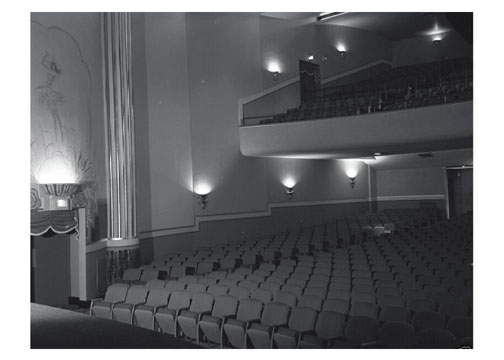
The outstanding embellishment consists of two large panels each side of the proscenium. They have allegorical figures of a fairy quality, dancing like the mist of the morning above clouds and masses of brilliant flowers of modern conventional design. There is however a dominant note of the theatre transcending the whole.
Of momentous importance are four beautiful columns, rising from floor to ceiling, richly decorated in gold and color flanking the above panels.
The lighting is particularly effective, illuminating panels from below and adding greatly to the artistic quality. A notable feature is the stage draperies. They are outstanding and very handsome. The fine comfortable seats are upholstered in aquamarine of contrasting harmonious shades a d blending perfectly with the rich carpet to complete the picture.
The foyer is in turquoise blue with mirrors and decorative wall panels following same general scheme of auditorium carried to include the spacious mezzanine foyer. The lobby is practical, unusual and rich in color and silver.
A large mezzanine story gives access to the balcony and provides a luxurious lounge and waiting room for the comfort of the patrons. Rest rooms, ladies powder room, public telephone booth, candy bar, etc are conveniently located on the ground floor.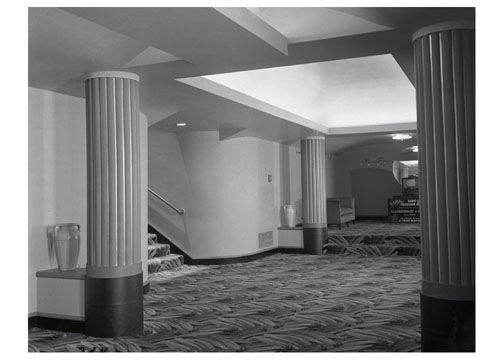
The entire building is air-conditioned and air cooled, with the latest General Electric heating ventilation and cooling equipment. The temperature and humidity is automatically controlled to maintain the exact conditions for comfort and health the year round. Large fans draw in the fresh outdoor air and deliver it through a vast concealed duct system to all sections of the building. In the winter this air is pre-heated and in the summer it is cooled by passing through refrigerated units and de-humidified to produce a cool, dry invigorating atmosphere.
The construction of the building is practically fireproof with concrete floors, steel and concrete balcony and metal lath and plaster on walls and ceilings. In addition, the building is equipped with a sprinkler system throughout, and for further protection of the public, an electronic device has been installed in the exhaust air ducts which stops all supply and exhaust fans at the first trace of smoke and flame. The Gorman is the first new theatre in New England so equipped.
Every effort has been made to produce a theatre of beauty with all the features of convenience, comfort, safety, and health.
Harry J. Korslund, architect for Norwood designed the theatre and the Platt Contracting Co. Inc. of Cambridge has done the construction of the 1000 seat house."
Closing in 1947, the Gorman reopened nine months later completely renovated, with
Anthony Capobianco, back from the Army, named Manager by it's new owners, General Cinema Corp.
James Collins, who came to Framingham in 1945 to succeed George Sumpter as manager of the St. George, remained there until 1952 when he became a Division Manager for the General Cinema.
Corporation. John Berry of Framingham, who now manages General Cinemas Natick Drive-In Theater, succeeded him. Joseph Goldberg came to Framingham in 1964 to manage the St. George and when that was razed, he transferred to the
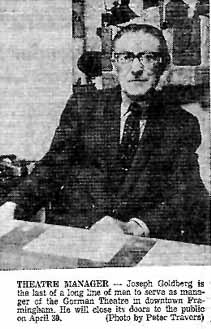
Gorman
Walter King of Maynard and Herbert Kenney of Framingham, now projectionists at the Cinema I & II Shoppers World, served in that capacity at the Gorman from 1942 until Cinema I, the pioneer of the present day shopping center theaters, conceived by the late president, Phillip Smith, opened in October 1951. King, who is also business agent for the International Alliance of Theatre StageHands and Motion Picture Projectionists of the United States and Canada, is among those with happy memories of the old theatre days.
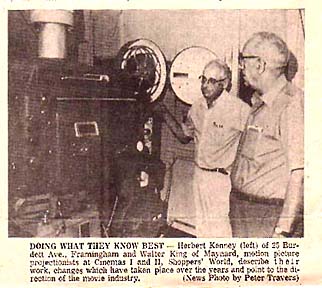
Talking with him in the projection room at the Cinema he said, "It breaks my heart to see a theatre close anywhere. I wouldn't even go downtown and watch them tear down the St. George even though I only worked there occasionally. I can still remember those old days when there were lines around the block leading from one theatre to the other. If one were filled, the people would just line up at the other one. Business was fantastic. You might say downtown Framingham was the showplace that Route 9 is today."
Frank Witcher recalled back in 1955 that the nickelodeon, stock, road shows, musical comedies, burlesque, one night shows and vaudeville, of many descriptions were popular features. One night shows boasted such celebrities as Rudy Vallee, William S. Hart, Vincent Lopez, and Douglas Fairbanks Sr. who were then coming into their own as entertainers.
